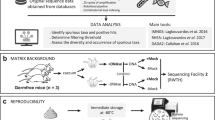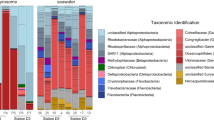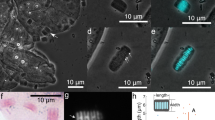Abstract
Deep-sequencing technologies are becoming nearly routine to describe microbial community composition in environmental samples. The 18S ribosomal DNA (rDNA) pyrosequencing has revealed a vast diversity of infrequent sequences, leading to the proposition of the existence of an extremely diverse microbial ‘rare biosphere’. Although rare microbes no doubt exist, critical views suggest that many rare sequences may actually be artifacts. However, information about how diversity revealed by molecular methods relates to that revealed by classical morphology approaches is practically nonexistent. To address this issue, we used different approaches to assess the diversity of tintinnid ciliates, a species-rich group in which species can be easily distinguished morphologically. We studied two Mediterranean marine samples with different patterns of tintinnid diversity. We estimated tintinnid diversity in these samples employing morphological observations and both classical cloning and sequencing and pyrosequencing of two different markers, the 18S rDNA and the internal transcribed spacer (ITS) regions, applying a variety of computational approaches currently used to analyze pyrosequence reads. We found that both molecular approaches were efficient in detecting the tintinnid species observed by microscopy and revealed similar phylogenetic structures of the tintinnid community at the species level. However, depending on the method used to analyze the pyrosequencing results, we observed discrepancies with the morphology-based assessments up to several orders of magnitude. In several cases, the inferred number of operational taxonomic units (OTUs) largely exceeded the total number of tintinnid cells in the samples. Such inflation of the OTU numbers corresponded to ‘rare biosphere’ taxa, composed largely of artifacts. Our results suggest that a careful and rigorous analysis of pyrosequencing data sets, including data denoising and sequence clustering with well-adjusted parameters, is necessary to accurately describe microbial biodiversity using this molecular approach.
Similar content being viewed by others
Log in or create a free account to read this content
Gain free access to this article, as well as selected content from this journal and more on nature.com
or
References
Agatha S, Strüder-Kypke MC . (2007). Phylogeny of the order Choreotrichida (Ciliophora, Spirotricha, Oligotrichea) as inferred from morphology, ultrastructure, ontogenesis, and SSrRNA gene sequences. Eur J Protistol 43: 37–63.
Altschul SF, Madden TL, Schaffer AA, Zhang J, Zhang Z, Miller W et al (1997). Gapped BLAST and PSI-BLAST: a new generation of protein database search programs. Nucleic Acids Res 25: 3389–3402.
Bachy C, López-García P, Vereshchaka A, Moreira D . (2011). Diversity and vertical distribution of microbial eukaryotes in the snow, sea ice and seawater near the North Pole at the end of the polar night. Front Microbiol 2: 106.
Bachy C, Gómez F, López-García P, Dolan JR, Moreira D . (2012). Molecular phylogeny of tintinnid ciliates (Tintinnida, Ciliophora). Protist 6: 873–887.
Bik HM, Sung WAY, De Ley P, Baldwin JG, Sharma J, Rocha-Olivares A et al (2012). Metagenetic community analysis of microbial eukaryotes illuminates biogeographic patterns in deep-sea and shallow water sediments. Mol Ecol 21: 1048–1059.
Brown MV, Philip GK, Bunge JA, Smith MC, Bissett A, Lauro FM et al (2009). Microbial community structure in the North Pacific ocean. ISME J 3: 1374–1386.
Caron DA, Countway PD, Savai P, Gast RJ, Schnetzer A, Moorthi SD et al (2009). Defining DNA-based operational taxonomic units for microbial-eukaryote ecology. Appl Environ Microbiol 75: 5797–5808.
Doherty M, Costas BA, McManus GB, Katz LA . (2007). Culture-independent assessment of planktonic ciliate diversity in coastal northwest Atlantic waters. Aquat Microb Ecol 48: 141–154.
Dolan JR, Claustre H, Carlotti F, Plounevez S, Moutin T . (2002). Microzooplankton diversity: relationships of tintinnid ciliates with resources, competitors and predators from the Atlantic Coast of Morocco to the Eastern Mediterranean. Deep Sea Res part I 49: 1217–1232.
Dolan JR, Lemée R, Gasparini S, Mousseau L, Heyndrickx C . (2006). Probing diversity in the plankton: using patterns in tintinnids (planktonic marine ciliates) to identify patterns. Hydrobiologia 555: 143–157.
Dolan JR, Ritchie ME, Tunin-Ley A, Pizay M-D . (2009). Dynamics of core and occasional species in the marine plankton: tintinnid ciliates in the north-west Mediterranean Sea. J Biogeogr 36: 887–895.
Edgar RC . (2010). Search and clustering orders of magnitude faster than BLAST. Bioinformatics 26: 2460–2461.
Edgcomb V, Orsi W, Bunge J, Jeon S, Christen R, Leslin C et al (2011). Protistan microbial observatory in the Cariaco Basin, Caribbean. I. Pyrosequencing vs Sanger insights into species richness. ISME J 5: 1344–1356.
Engelbrektson A, Kunin V, Wrighton KC, Zvenigorodsky N, Chen F, Ochman H et al (2010). Experimental factors affecting PCR-based estimates of microbial species richness and evenness. ISME J 4: 642–647.
Gihring TM, Green SJ, Schadt CW . (2012). Massively parallel rRNA gene sequencing exacerbates the potential for biased community diversity comparisons due to variable library sizes. Environ Microbiol 14: 285–290.
Guillou L, Viprey M, Chambouvet A, Welsh RM, Kirkham AR, Massana R et al (2008). Widespread occurrence and genetic diversity of marine parasitoids belonging to Syndiniales (Alveolata). Environ Microbiol 10: 3349–3365.
Haas BJ, Gevers D, Earl AM, Feldgarden M, Ward DV, Giannoukos G et al (2011). Chimeric 16S rRNA sequence formation and detection in Sanger and 454-pyrosequenced PCR amplicons. Genome Res 21: 494–504.
Huber JA, Morrison HG, Huse SM, Neal PR, Sogin ML, Mark Welch DB . (2009). Effect of PCR amplicon size on assessments of clone library microbial diversity and community structure. Environ Microbiol 11: 1292–1302.
Hughes JB, Hellmann JJ, Ricketts TH, Bohannan BJM . (2001). Counting the uncountable: statistical approaches to estimating microbial diversity. Appl Environ Microbiol 67: 4399–4406.
Huse SM, Huber JA, Morrison HG, Sogin ML, Welch DM . (2007). Accuracy and quality of massively parallel DNA pyrosequencing. Genome Biol 8: R143.
Huse SM, Welch DM, Morrison HG, Sogin ML . (2010). Ironing out the wrinkles in the rare biosphere through improved OTU clustering. Environ Microbiol 12: 1889–1898.
Jobb G, von Haeseler A, Strimmer K . (2004). TREEFINDER: a powerful graphical analysis environment for molecular phylogenetics. BMC Evol Biol 4: 18.
Katoh K, Misawa K, Kuma K, Miyata T . (2002). MAFFT: a novel method for rapid multiple sequence alignment based on fast Fourier transform. Nucleic Acids Res 30: 3059–3066.
Kofoid CA, Campbell AS . (1929) A Conspectus of the Marine and Freshwater Ciliata Belonging to the Suborder Tintinnoinea, with Descriptions of New Species Principally from the Agassiz Expedition to the Eastern Tropical Pacific vol 34. Univ Calif Publs Zool 1904–1905.
Kofoid CA, Campbell AS . (1939). The Ciliata: the Tintinnoinea. Bull Mus Comp Zool Harvard 84: 1–473.
Kunin V, Engelbrektson A, Ochman H, Hugenholtz P . (2010). Wrinkles in the rare biosphere: pyrosequencing errors lead to artificial inflation of diversity estimates. Environ Microbiol 12: 118–123.
López-García P, Rodriguez-Valera F, Pedros-Alio C, Moreira D . (2001). Unexpected diversity of small eukaryotes in deep-sea Antarctic plankton. Nature 409: 603–607.
López-García P, Philippe H, Gail F, Moreira D . (2003). Autochthonous eukaryotic diversity in hydrothermal sediment and experimental microcolonizers at the Mid-Atlantic Ridge. Proc Natl Acad Sci USA 100: 697–702.
Margulies M, Egholm M, Altman WE, Attiya S, Bader JS, Bemben LA et al (2005). Genome sequencing in microfabricated high-density picolitre reactors. Nature 437: 376–380.
Marshall SM . (1969). Protozoa, order Tintinnia. Conseil International pour l'exploration de la Mer, Fiches d'Identification de Zooplancton: fiches. Copenhagen, Denmark, pp 117–127.
Massana R, Pedrós-Alió C . (2008). Unveiling new microbial eukaryotes in the surface ocean. Curr Opin Microbiol 11: 213–218.
Medinger R, Nolte V, Pandey RV, Jost S, Ottenwalder B, Schlotterer C et al (2010). Diversity in a hidden world: potential and limitation of next-generation sequencing for surveys of molecular diversity of eukaryotic microorganisms. Mol Ecol 19: 32–40.
Moon-van der Staay SY, De Wachter R, Vaulot D . (2001). Oceanic 18S rDNA sequences from picoplankton reveal unsuspected eukaryotic diversity. Nature 409: 607–610.
Not F, Gausling R, Azam F, Heidelberg JF, Worden AZ . (2007a). Vertical distribution of picoeukaryotic diversity in the Sargasso Sea. Environ Microbiol 9: 1233–1252.
Not F, Valentin K, Romari K, Lovejoy C, Massana R, Tobe K et al (2007b). Picobiliphytes: a marine picoplanktonic algal group with unknown affinities to other eukaryotes. Science 315: 253–255.
Pedrós-Alió C . (2007). Dipping into the rare biosphere. Science 315: 192–193.
Philippe H . (1993). MUST, a computer package of Management Utilities for Sequences and Trees. Nucleic Acids Res 21: 5264–5272.
Pierce RW, Turner JT . (1993). Global biogeography of marine tintinnids. Mar Ecol Prog Ser 94: 11–26.
Price MN, Dehal PS, Arkin AP . (2009). FastTree: computing large minimum evolution trees with profiles instead of a distance matrix. Mol Biol Evol 26: 1641–1650.
Quince C, Lanzen A, Curtis TP, Davenport RJ, Hall N, Head IM et al (2009). Accurate determination of microbial diversity from 454 pyrosequencing data. Nat Methods 6: 639–641.
Quince C, Lanzen A, Davenport RJ, Turnbaugh PJ . (2011). Removing noise from pyrosequenced amplicons. BMC Bioinformatics 12: 38.
Reeder J, Knight R . (2009). The ‘rare biosphere’: a reality check. Nat Methods 6: 636–637.
Saccà A, Strüder-Kypke MC, Lynn DH . (2012). Redescription of Rhizodomus tagatzi (Ciliophora: Spirotrichea: Tintinnida), based on morphology and small subunit ribosomal rna gene sequence. J Eukaryot Microbiol 59: 218–231.
Santoferrara LF, McManus GB, Alder VA . (2012). Utility of genetic markers and morphology for species discrimination within the Order Tintinnida (Ciliophora, Spirotrichea). Protist; e-pub ahead of print 18 January 2012; doi:10.1016/j.protis.2011.12.002.
Schloss PD, Westcott SL, Ryabin T, Hall JR, Hartmann M, Hollister EB et al (2009). Introducing mothur: Open-source, platform-independent, community-supported software for describing and comparing microbial communities. Appl Environ Microbiol 75: 7537–7541.
Schloss PD . (2010). The effects of alignment quality, distance calculation method, sequence filtering, and region on the analysis of 16S rRNA gene-based studies. PLoS Comput Biol 6: e1000844.
Snoeyenbos-West OLO, Salcedo T, McManus GB, Katz LA . (2002). Insights into the diversity of choreotrich and oligotrich ciliates (Class: Spirotrichea) based on genealogical analyses of multiple loci. Int J Syst Evol Microbiol 52: 1901–1913.
Sogin ML, Morrison HG, Huber JA, Welch DM, Huse SM, Neal PR et al (2006). Microbial diversity in the deep sea and the underexplored ‘rare biosphere’. Proc Natl Acad Sci USA 103: 12115–12120.
Stoeck T, Bass D, Nebel M, Christen R, Jones MDM, Breiner H-W et al (2010). Multiple marker parallel tag environmental DNA sequencing reveals a highly complex eukaryotic community in marine anoxic water. Mol Ecol 19: 21–31.
Strüder-Kypke MC, Lynn DH . (2008). Morphological versus molecular data - Phylogeny of tintinnid ciliates (Ciliophora, Choreotrichia) inferred from small subunit rRNA gene sequences. Denisia 23: 417–424.
Sun Y, Cai Y, Liu L, Yu F, Farrell ML, McKendree W et al (2009). ESPRIT: estimating species richness using large collections of 16S rRNA pyrosequences. Nucleic Acids Res 37: e76.
Tedersoo L, Nilsson RH, Abarenkov K, Jairus T, Sadam A, Saar I et al (2010). 454 Pyrosequencing and Sanger sequencing of tropical mycorrhizal fungi provide similar results but reveal substantial methodological biases. New Phytol 188: 291–301.
Wu S, Zhu Z, Fu L, Niu B, Li W . (2011). WebMGA: a customizable web server for fast metagenomic sequence analysis. BMC Genomics 12: 444.
Zinger L, Gobet A, Pommier T . (2012). Two decades of describing the unseen majority of aquatic microbial diversity. Mol Ecol 21: 1878–1896.
Acknowledgements
We are thankful to L Gasperini and G Bortoluzzi of the Istituto di Geologia Marina (ISMAR), CNR, Bologna (Italy) for allowing PL-G to participate in the Marmara 2010 cruise. We kindly thank the officers and the crew as well as the scientific team on-board of the RV Urania for operating the CTD rosette and providing helpful assistance. We acknowledge financial support from the French CNRS and the ANR programs Biodiversity (ANR BDIV 07 004-02 ‘Aquaparadox’) and Génomique microbienne à grande échelle (ANR-08-GENM-024-001, EVOLDEEP). We thank two anonymous referees for their useful suggestions.
Author information
Authors and Affiliations
Corresponding author
Ethics declarations
Competing interests
The authors declare no conflict of interest.
Additional information
Supplementary Information accompanies the paper on The ISME Journal website
Supplementary information
Rights and permissions
About this article
Cite this article
Bachy, C., Dolan, J., López-García, P. et al. Accuracy of protist diversity assessments: morphology compared with cloning and direct pyrosequencing of 18S rRNA genes and ITS regions using the conspicuous tintinnid ciliates as a case study. ISME J 7, 244–255 (2013). https://doi.org/10.1038/ismej.2012.106
Received:
Revised:
Accepted:
Published:
Issue date:
DOI: https://doi.org/10.1038/ismej.2012.106
Keywords
This article is cited by
-
Improved phyllosphere microbiome composition of tea plant with the application of small peptides in combination with rhamnolipid
BMC Microbiology (2023)
-
Eukaryotic food sources analysis in situ of tropical common sea cucumber Holothuria leucospilota based on 18S rRNA gene high-throughput sequencing
Journal of Oceanology and Limnology (2023)
-
Progress in studies on the diversity and distribution of planktonic ciliates (Protista, Ciliophora) in the South China Sea
Marine Life Science & Technology (2021)
-
Use of High-Throughput Sequencing to Identify Fungal Communities on the Surface of Citri Reticulatae Pericarpium During the 3-Year Aging Process
Current Microbiology (2021)
-
Complementary DNA sequencing (cDNA): an effective approach for assessing the diversity and distribution of marine benthic ciliates along hydrographic gradients
Journal of Oceanology and Limnology (2021)



